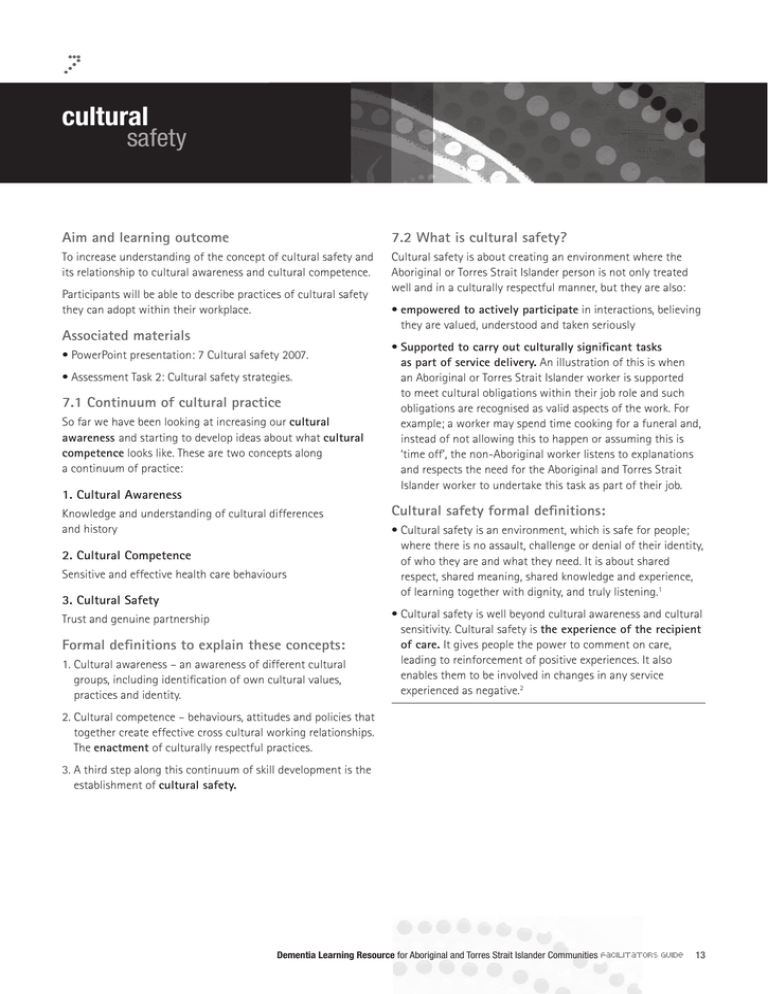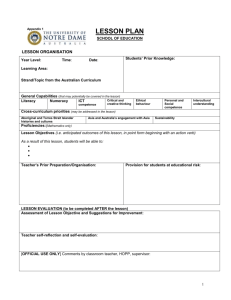Cultural Safety
advertisement

7 cultural safety Aim and learning outcome 7.2 What is cultural safety? To increase understanding of the concept of cultural safety and its relationship to cultural awareness and cultural competence. Cultural safety is about creating an environment where the Aboriginal or Torres Strait Islander person is not only treated well and in a culturally respectful manner, but they are also: Participants will be able to describe practices of cultural safety they can adopt within their workplace. Associated materials • PowerPoint presentation: 7 Cultural safety 2007. • Assessment Task 2: Cultural safety strategies. 7.1 Continuum of cultural practice So far we have been looking at increasing our cultural awareness and starting to develop ideas about what cultural competence looks like. These are two concepts along a continuum of practice: 1. Cultural Awareness Knowledge and understanding of cultural differences and history 2. Cultural Competence Sensitive and effective health care behaviours 3. Cultural Safety Trust and genuine partnership Formal definitions to explain these concepts: 1. Cultural awareness – an awareness of different cultural groups, including identification of own cultural values, practices and identity. • e mpowered to actively participate in interactions, believing they are valued, understood and taken seriously • S upported to carry out culturally significant tasks as part of service delivery. An illustration of this is when an Aboriginal or Torres Strait Islander worker is supported to meet cultural obligations within their job role and such obligations are recognised as valid aspects of the work. For example; a worker may spend time cooking for a funeral and, instead of not allowing this to happen or assuming this is ‘time off’, the non-Aboriginal worker listens to explanations and respects the need for the Aboriginal and Torres Strait Islander worker to undertake this task as part of their job. Cultural safety formal definitions: • Cultural safety is an environment, which is safe for people; where there is no assault, challenge or denial of their identity, of who they are and what they need. It is about shared respect, shared meaning, shared knowledge and experience, of learning together with dignity, and truly listening.1 • Cultural safety is well beyond cultural awareness and cultural sensitivity. Cultural safety is the experience of the recipient of care. It gives people the power to comment on care, leading to reinforcement of positive experiences. It also enables them to be involved in changes in any service experienced as negative.2 2. Cultural competence – behaviours, attitudes and policies that together create effective cross cultural working relationships. The enactment of culturally respectful practices. 3. A third step along this continuum of skill development is the establishment of cultural safety. Dementia Learning Resource for Aboriginal and Torres Strait Islander Communities Facilitators Guide 13 ASSESSMENT TASK 2: CULTURAL SAFETY STRATEGIES 1. In small groups consider how cultural safety can be created in your workplace. Discuss and write down a range of activities that you can feed back to the larger group. 2. The facilitator will invite a whole group discussion to share everyone’s ideas. 3. From the group discussion, choose at least three strategies that you will be able to personally put into practice. Record these individually on your assessment sheet and hand in to the facilitator. In summary, to be skilled in practices of cultural respect and work effectively with Aboriginal and Torres Strait communities we must: • n otice our own cultural practices and individual behaviours and the impact these may have on Aboriginal and Torres Strait Islander people • u nderstand and acknowledge the impact of our shared history since European invasion • learn about Aboriginal and Torres Strait Islander people’s diverse cultures and what is important to them • a ct differently to our usual culturally preferred ways, in order to respond to the issues we have learnt about • take initiative to create cultural safety • c ontinuously review and be open to direct and indirect feedback. 14 Dementia Learning Resource for Aboriginal and Torres Strait Islander Communities Facilitators Guide




